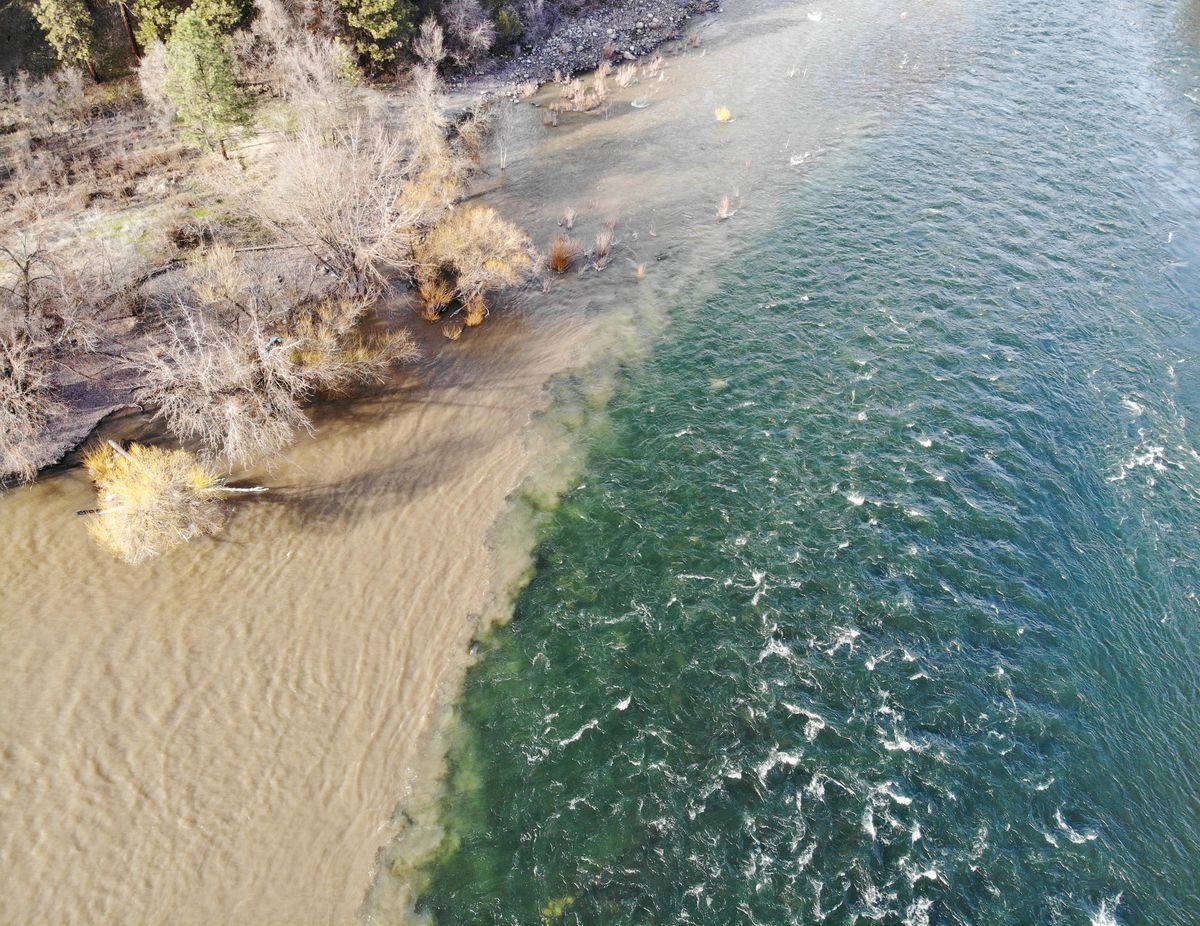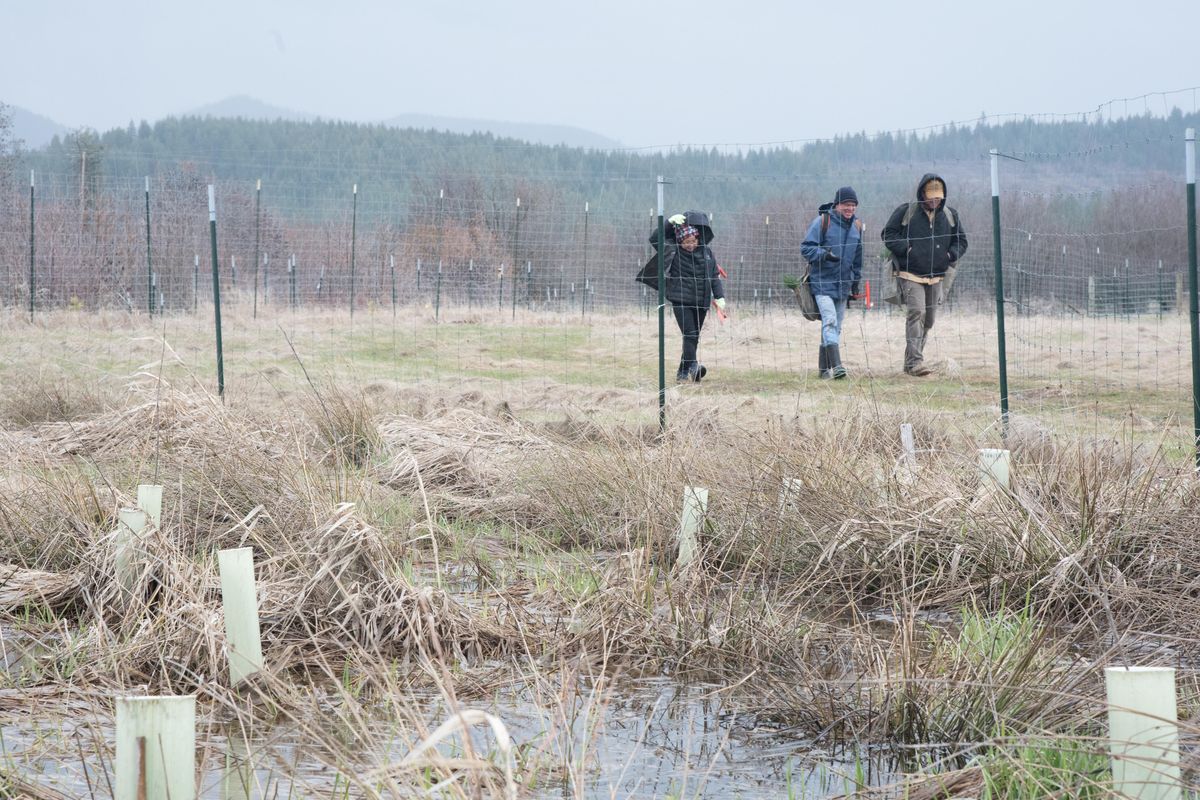Coeur d’Alene Tribe, Spokane Trout Unlimited working to restore Hangman Creek, return salmon to their native waters

In a long steel container, hundreds of salmon fry flit about in coordinated flight. Above them, 10 volunteers from the Spokane chapter of Trout Unlimited peer at the tiny fish, their shadows inadvertently prompting the rapid movements.
They’re all in an unassuming warehouse in Plummer, Idaho, owned by the Coeur d’Alene Tribe, on April 13.
Their mission?
Plant trees along the banks of Hangman Creek.
It’s a longstanding restoration effort aimed at reducing erosion and runoff. After more than a century of degradation, Hangman Creek runs frothy and full of silt during the spring.
The effluent is visible to anyone who has walked near the confluence of the creek and the Spokane River near People’s Park, where the frothy outpouring collides in a striking visual juxtaposition with the clearer waters of the Spokane River.
While erosion control and creek restoration remain the focus of the day, the baby salmon represent a much larger aspiration: the return of salmon to Hangman Creek and, by extension, the healing of a long-damaged watershed.
“The Hangman watershed has always been really important to the Coeur d’Alene Tribe,” said Caj Matheson, the director of the tribe’s natural resources department. “There is an emotional attachment we have to that watershed that is important to us.”

A visible pollutant
Hangman Creek may be the region’s most visible pollutant. Unlike microplastics, carbon dioxide or heavy metals, the annual deluge of dirt is clear for all to see.
And yet, the muddy stream remains a constant of the spring runoff.
“They have been working on that for 20 years up there, just the head water parts of it,” said Chuck Lee, a fish biologist for the Washington Department of Fish and Wildlife. “It’s such a long process to heal a stream that’s been degraded for over a hundred years.”
The pollution comes from a combination of factors. The 60-mile-long creek starts in the Moses Mountains near the Coeur d’Alene Indian Reservation. From there, it winds its way through the famously rich and deep Palouse topsoil.
The topsoil, which itself is effluent from the cataclysmic Missoula Floods, sloughs away easily when not anchored by tree roots. Traditionally, the area directly adjacent to Hangman Creek was full of trees and other plants that anchored the soil like any healthy riparian system. Farmers cleared trees and grew crops right to the edge of the creek, however, removing the larger plants that rooted the soil in place.
At the same time, early settlers straightened the streams for agricultural purposes. This caused the water to run faster and dig deep channels into the earth. The water stopped seeping out into the surrounding lands, rushing in one headlong dash into the Spokane River, carrying whatever soil it swept up on its way.
Cattle are another minor but still important factor. Free-roaming bovine head into the stream looking for a place to cool down. Their hooves churn up more mud, and their feces pollute the water.
“Hangman Creek was originally like nothing that it is today,” said Alan Scholz, a former fisheries professor at Eastern Washington University who has researched the stream extensively.
Tribal descriptions recount a shaded meandering creek supporting “good bunchgrass, large pine trees, both sharp-tailed and ruffed grouse, and snowshoe hare,” historian and naturalist Jack Nisbet writes in North Columbia Monthly. “Salmon, trout and whitefish ascended the creek and provided people with food for the winter months.”
Some sources estimate tribal anglers took 1,000 chinook salmon from the mouth of Hangman Creek every day for up to 30 days. Even after whites settled in the area and degraded the creek, salmon continued to travel upstream through Spokane, all the way to the headwaters of Hangman Creek. Early hotels in Spokane catered to salmon anglers, and the Spokane River had steelhead runs, a coho run and a huge population of cutthroat trout.
“That watershed has always been a celebratory watershed for us,” Matheson said.
Hangman Creek’s pollution problems are not the reason why salmon are gone. That can be blamed on the Long Lake and Grand Coulee dams, both of which blocked the migratory fish’s return to its upstream spawning grounds.
Still, for the Coeur d’Alene Tribe, the rehabilitation of Hangman Creek is an aspirational task.
“Our goal in the fisheries program is to help prepare that home for them,” Matheson said.
In the process, it’s improving habitat for a fish that still calls Hangman Creek, and the greater Spokane system, home.
Redband trout.
‘This is not normal’
On a sunny early April day, Jerry White stares intently into a tube of water taken near the confluence of Hangman Creek and the Spokane River.
It’s murky. With his right hand, he drains water from the clear plastic tube in a steady stream while keeping his eye glued to the top of the tube.
He’s measuring the clearness of the water, also known as turbidity. It’s a rough estimate of how many pollutants are in a body of water. The viewer drains the water until he can see the bottom of the tube. The turbidity rating depends on how much water is left when the tiny target comes into view.
On this day, the water is brown and murky, although White said it’s better than it was a week ago, when the creek was really raging.
Still, looking into the murky tube, White isn’t happy.
“This is not normal,” he said. This is pollution.”
Harvey Morrison, the conservation chair for the Spokane Falls Chapter of Trout Unlimited, points out that just upstream above the confluence the water would be clear.
Hangman Creek’s runoff has a clear and present impact on Spokane’s namesake river.
What’s less clear is how the water impacts the native redband trout.
Particulates in water are not good for fish. That is known.
“Just in general, fish try to avoid that sediment when possible,” Randy Osborne, a Washington Fish and Wildlife Department fisheries biologist. “It’s abrasive on their gills.”
Silt and dirt can also fill in the gravel beds in which fish spawn, covering eggs and suffocating them. Osborne said silt is like smog, except fish can’t wear masks.
What isn’t clear is the impact Hangman Creek’s runoff has on redband dispersal and prevalence in the Spokane River. Lee, the fish biologist for WDF who studies redbands, said he doesn’t know of research looking specifically at that question.
“It obviously probably leads to some sort of sediment embedness,” Lee said, hedging in lieu of a more rigorous scientific analysis.
That’s not an uncommon response when talking about the Spokane River. Whether it’s levels of microplastics, historical water temperatures or impacts of sediment runoff on fish, the Spokane River remains relatively unstudied.
A few studies were done long after Hangman Creek was a polluted mess and provide little in the way of a comparative starting point.
For example: Redband don’t spawn near the confluence, but Lee said they might have at one time.
This is what White, Morrison and others are trying to address. Through various grant-funded projects and citizen science initiatives, the Spokane Riverkeeper and others hope to develop a fuller picture of the Spokane River and its tributaries.
As a part of that effort, Trout Unlimited volunteers have been taking turbidity samples from the water for the past year. For the past four years, Trout Unlimited volunteers have partnered with the Coeur d’Alene Tribe in their ongoing upstream restoration work.
“It’s hard to have much more than a small impact at this point. But we do what we can,” said Hilary Hart, the president of the Spokane Falls Trout Unlimited chapter. “What we’re concentrating on is the tributaries that are still holding native fish.”
‘Natural environmentalists’
Back on the Coeur d’Alene Reservation, Ka-ten Hoy-ten Stanger, a tribal elder, is singing an honor song and welcoming the 10 Trout Unlimited volunteers. Stanger is dressed in full regalia and dances inside another cavernous Coeur d’Alene tribal fisheries warehouse.
“We’ve been here from time immemorial,” Stanger said to the assembled group. “We’ve been natural environmentalists.”
Outside the wide garage bay doors, it’s lightly raining. Hangman Creek is barely visible. This section has been healed after nearly 20 years of work. The creek bends and turns, winding its way downstream, often spilling its banks. Beavers live here, trees line the waterway and the creek runs cool, even in the summer.
Upstream from here, near the creek’s headwaters, trout are still found, although miles of polluted water keep them isolated from their Spokane brethren. Although it seems impossible, salmon could one day return to this waterway.
As Stanger dances, Hemene James watches from the corner. A tribal member, he’s heard stories from his grandfather of seeing salmon near De Smet, Idaho, just a generation ago.
“This is a cultural heritage issue,” White told the assembled Trout Unlimited Volunteers. “In many ways, it’s a cultural justice issue.”